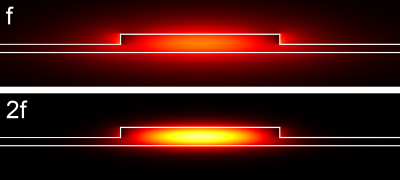
E. Timurdogan*, C. V. Poulton, M. J. Byrd and M. R. Watts
DOI: 10.1038/NPHOTON.2017.14
Abstract:
The symmetry of crystalline silicon inhibits a second-order optical nonlinear susceptibility, χ (2), in complementary metal– oxide–semiconductor-compatible silicon photonic platforms. However, χ (2) is required for important processes such as phase-only modulation, second-harmonic generation (SHG) and sum/difference frequency generation. Here, we break the crystalline symmetry by applying direct-current fields across p–i–n junctions in silicon ridge waveguides and induce a χ (2) proportional to the large χ (3) of silicon. The obtained χ (2) is first used to perturb the permittivity (the direct-current Kerr effect) and achieve phase-only modulation. Second, the spatial distribution of χ (2) is altered by periodically patterning p–i–n junctions to quasi-phase-match pump and second-harmonic modes and realize SHG. We measure a maximum SHG efficiency of P2ω/Pω 2 = 13 ± 0.5% W−1 at λω = 2.29 µm and with field-induced χ (2) = 41 ± 1.5 pm V–1 . We expect such fieldinduced χ (2) in silicon to lead to a new class of complex integrated devices such as carrier-envelope offset frequency stabilizers, terahertz generators, optical parametric oscillators and chirp-free modulators.
